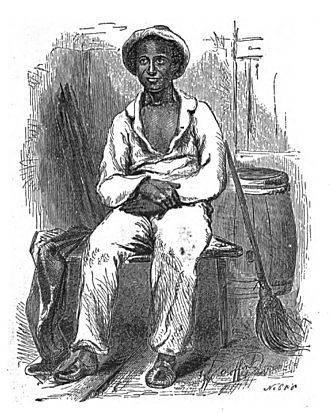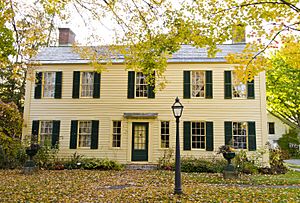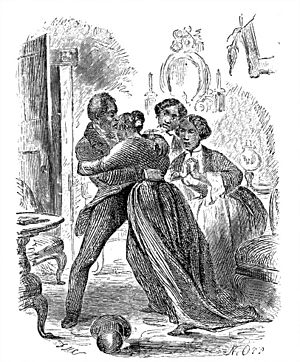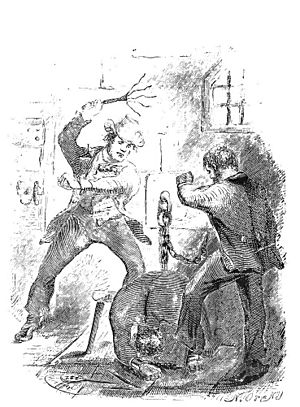Solomon Northup facts for kids
Quick facts for kids
Solomon Northup
|
|
|---|---|

Engraving from his autobiography
|
|
| Born |
Solomon Northup
July 10, 1807 or 1808 Minerva, New York, U.S.
|
| Died | between 1857 and 1875 |
| Occupation |
Author
|
| Known for | Writing Twelve Years a Slave |
| Signature | |
Solomon Northup (born July 10, c. 1807 or 1808) was an American abolitionist and the primary author of the memoir Twelve Years a Slave. A free-born African American from New York, he was the son of a freed slave and a free woman of color. A farmer and a professional violinist, Northup had been a landowner in Washington County, New York. In 1841, he was offered a traveling musician's job and went to Washington, D.C. (where slavery was legal); there he was kidnapped and sold as a slave. He was shipped to New Orleans, purchased by a planter, and held as a slave for 12 years in the Red River region of Louisiana, mostly in Avoyelles Parish. He remained a slave until he met Samuel Bass, a Canadian working on his plantation who helped get word to New York, where state law provided aid to free New York citizens who had been kidnapped and sold into slavery. His family and friends enlisted the aid of the Governor of New York, Washington Hunt, and Northup regained his freedom on January 3, 1853.
The slave trader in Washington, D.C., James H. Birch, was arrested and tried, but acquitted because District of Columbia law at the time prohibited Northup as a black man from testifying against white people. Later, in New York State, his northern kidnappers were located and charged, but the case was tied up in court for two years because of jurisdictional challenges and finally dropped when Washington, D.C. was found to have jurisdiction. The D.C. government did not pursue the case. Those who had kidnapped and enslaved Northup received no punishment.
In his first year of freedom, Northup wrote and published a memoir, Twelve Years a Slave (1853). He lectured on behalf of the abolitionist movement, giving more than two dozen speeches throughout the Northeast about his experiences, to build momentum against slavery. He largely disappeared from the historical record after 1857, although a letter later reported him alive in early 1863; some commentators thought he had been kidnapped again, but historians believe it unlikely, as he would have been considered too old to bring a good price. The details of his death have never been documented.
Northup's memoir was adapted and produced as the 1984 television film Solomon Northup's Odyssey and the 2013 feature film 12 Years a Slave. The latter won three Academy Awards, including Best Picture, at the 86th Academy Awards.
Contents
Early life
Solomon Northup was born in the town of Minerva in Essex County, New York on July 10, 1807 or July 10, 1808. His mother was a free woman of color, which meant that their sons, Solomon and his older brother Joseph, were born free according to the principle of partus sequitur ventrem. Solomon described his mother as a quadroon, meaning that she was one-quarter African, and three-quarters European.
His father Mintus was a freedman who had been a slave in his early life in service to the Northup family. Born in Rhode Island, he was taken with the Northups when they moved to Hoosick, New York, in Rensselaer County. His master, Henry Northrop, manumitted Mintus in his will, after which Mintus adopted the surname Northup. His surname was sometimes spelled Northrup in records. Upon attaining his freedom, Mintus married and he moved to Minerva with his wife.
According to Northup, his father was "a man respected for his industry and integrity". A farmer, Mintus was successful enough to own land and thus meet the state's property requirements for the right to vote. His sons received what was considered to be a good education for free black people at that time. As boys, Northup and his brother worked on the family farm. He spent his leisure time playing the violin and reading books.

Mintus moved his family to Washington County, New York and worked on several farms owned by the Northups. From Minerva, they moved to the farm of Clark Northup near Slyborough (Slyboro) in Granville, Washington County for several years. The family of four then lived at Alden Farm, a short distance north of Sandy Hill (now called Hudson Falls). They later moved to an area east of Fort Edward on the road from Fort Edward to Argyle, where Mintus lived until his death. Mintus died at Fort Edward on November 22, 1829, and was interred at the Hudson Falls Baker Cemetery. His mother died during Northup's enslavement (1841 to 1852). According to her daughter-in-law Anne and Nicholas C. Northup, she died around 1846 or 1847 in Oswego County, New York.
Marriage and family
Solomon Northup married Anne Hampton on December 25, 1829, one month after the death of his father, or on December 25, 1828, according to sworn depositions by Anne Northup, Josiah Hand, and Timothy Eddy, the latter of whom was the Justice of the Peace who performed the wedding. They were married in Fort Edward. Anne, the daughter of William Hampton, was born March 14, 1808. She grew up in Sandy Hill. A "woman of color", she was of African, European, and Native American descent. They had three children: Elizabeth (born ca. 1831), Margaret (born ca. 1833), and Alonzo (born ca. 1835).
At the start of their marriage, the couple lived at Fort House, "the old yellow house", in the southern end of Fort Edward. In 1830, they moved to Kingsbury, both of which were small communities in Washington County, New York. After selling their farm in 1834, the Northups moved 20 miles to Saratoga Springs, New York, for its employment opportunities.
Anne was known for her culinary expertise. She worked for local taverns that served food and drink, and at the United States Hotel. When court was in session at the county seat of Fort Edward, she worked at Sherrill's Coffee House in Sandy Hill.
After Northrup was kidnapped, Anne and her oldest daughter Elizabeth went to work as domestic servants in New York City at Madame Jumel's Mansion on the East River in the summer of 1841. Alonzo was with them. Margaret, their youngest daughter went to Hoboken, New Jersey to live with a friend of Madame Jumel, who also had a young daughter.
After about two years, Anne brought the family back together in Saratoga, where she worked as a cook in hotels, including in Glens Falls at Carpenter's Hotel. In 1852, she learned of her husband's fate and asked for Henry B. Northup's help to have him freed. A letter was prepared to the Governor of New York Washington Hunt based upon a deposition given by Anne Northup to Justice of the Peace Charles Hughes on November 19, 1852. He gathered the information to prove that Northup was free and went to Louisiana to bring him back to New York.
Northup returned to Sandy Hill on January 21, 1853, and reunited with his wife and children. By 1855, he was living with his daughter Margaret Stanton and her family in Queensbury, Warren County, New York. He purchased land in Glens Falls near his daughter. In his memoir, Northup described his love for his wife as "sincere and unabated", since the time of their marriage, and his children as "beloved".
While Northup gave talks about his book around the country, Anne worked in Bolton Landing on Lake George at the hotel Mohican House. Author David Fiske states that Northup seems to have had a difficult time overcoming the years in which he was enslaved. By the late 1850s, it was not known what had become of Northup, and he was not listed with his family in the 1860 census.
After selling their land in Glens Falls, Anne Northup moved to the household of her daughter and son-in-law, Margaret and Philip Stanton, in Moreau, Saratoga County, where she again was recorded as married though Solomon was not with the family. Anne did laundry, cooking and chores for a Moreau man. In 1870, she worked as a cook in the household of Burton C. Dennis, who kept the Middleworth House hotel in Sandy Hill. Anne Northup lived in Kingsbury in Washington County, New York in 1875. By that time she was identified as a widow. She died in 1876 while performing her chores in Moreau. One obituary, while praising Anne, says of Solomon Northup that "after exhibiting himself through the country [he] became a worthless vagabond".
Life
Canal worker, farmer, and violin player
In the winter of the year that he married, Northup worked as a laborer repairing the Champlain Canal. He then bought two horses and contracted to tow lumber on rafts to Troy from Lake Champlain beginning the following spring. He employed two workers. He worked on other waterways in upstate New York and he traveled to northern New York and Montreal, Canada. When the canal was closed down, he cut lumber during the winter of 1831–1832. He worked as a farm laborer in the Sandy Hill area.
He arranged to farm corn and oats on part of the Alden farm where his father lived in Kingsbury. He built a fine reputation as a fiddler and was in high demand to play for dances in surrounding villages. The couple had become prosperous due to the income Anne received as a cook and that Northup made farming and playing the violin.
The couple moved to Saratoga Springs in March 1834, where he drove a horse-drawn taxi for a businessman, and during the tourist season he worked for the United States Hotel, where he was employed by Judge James M. Marvin, a part-owner of the hotel. He played his violin at several well-known hotels in Saratoga Springs. He also worked on the construction of the Troy and Saratoga Railroad. He had become a regular customer and friend of William Perry and Cephus Parker, who owned several shops in town. Over the seven years that the Northups lived in Saratoga Springs, they had been able to make ends meet and dress their children in fine clothes, but they had been unable to prosper as hoped.
In March 1841, Anne went 20 miles to Sandy Hill where she ran the kitchen at Sherrill's Coffee House during the session of the court. She may have taken their oldest daughter Elizabeth with her. Their two youngest children went to stay with their aunt. Northup stayed in Saratoga Springs to look for employment until the tourist season.
Restoration of freedom
Bass wrote several letters to people Northup knew in Saratoga Springs: one went to his former employer Judge James M. Marvin and another reached Cephas Parker and William Perry, storekeepers in Saratoga. Parker and Perry forwarded the letter to Northup's wife, Anne, who contacted attorney Henry B. Northup, the son of Solomon's father's former master. Henry B. Northup contacted New York Governor Washington Hunt, who took up the case, appointing the attorney general as his legal agent. In 1840, the New York State Legislature had passed a law committing the state to help any African-American residents kidnapped into slavery, as well as guaranteeing a jury trial to alleged fugitive slaves. Once Northup's family was notified, his rescuers still had to do detective work to find the enslaved man, as he had partially tried to hide his location for protection in case the letters fell into the wrong hands, and Bass had not used his real name. They had to find documentation of his free status as a citizen and New York resident; Henry B. Northup also collected sworn affidavits from people who knew Solomon Northup. During this time, Northup did not know if Bass had reached anyone with the letters. There was no means of communicating, because of the secrecy they needed to maintain, and the necessity of preventing Northup's owner from knowing their plans. Bass did not reveal his own name in the letter.
Henry gathered documentation and depositions and stopped off in Washington, D.C. to meet with Pierre Soule, a legislator from Louisiana, and the Secretary of War in preparation for his rescue effort in Louisiana. Although he did not have Bass's name, Henry still managed to find him in Marksville (the postmark on the letters), and Bass revealed that Solomon Northup was held by Edwin Epps on his plantation. Henry had legal paperwork prepared based upon the documentation that proved that Northup was free. The sheriff went with Henry to give the news to Epps and take Northup off the farm.
Northup later wrote, "He [Epps] thought of nothing but his loss, and cursed me for having been born free." Attorney Henry B. Northup convinced Epps that it would be futile to contest the free papers in a court of law, so the planter conceded the case. He signed papers giving up all claim to Northup. Finally on January 4, 1853, four months after meeting Bass, Northup regained his freedom.
Twelve Years a Slave
After he made it back to New York, Solomon Northup wrote and published his memoir, Twelve Years a Slave (1853). The book was written in three months with the help of David Wilson, a local lawyer and writer.
Northup told the story of his kidnapping and enslavement with many verifiable details. Northup told the cruelty, treatment as chattel, and the appreciated acts of kindnesses that he received. "Its tone is much milder than we expected to see exhibited," according to the Rome Citizen of New York. The detail that he provided helped illuminate the depth of his experiences, and allowed for verification of what life was like on a plantation. Sue Eakin and Joseph Logsdon researched the facts from Northup's book and were able to verify many of the events and people and published their annotated version of the book in 1968. Edwin Epps, his slaveholder, stated that a greater part of the book was the truth to soldiers from the 114th New York Infantry Regiment that Epps met during the Civil War. Northup was literate and provided the facts without hyperbole in "plain and candid language", while Wilson corrected style, grammar, and inconsistencies.
It was published by Derby & Miller of Auburn, New York. In the period when questions of slavery generated debate and the novel Uncle Tom's Cabin (1852) by Harriet Beecher Stowe was a bestseller, Northup's book sold 30,000 copies within three years, also becoming a bestseller. Northup traveled and went on a lecture tour in Northeastern states to tell his story and sell books. The book became the backbone of other books about him, such as Solomon Northup: The Complete Story of the Author of Twelve Years a Slave.
Court cases
Northup was one of the few kidnapped free black people to regain freedom after being sold into slavery. Represented by attorneys Senator Salmon P. Chase of Ohio, General Orville Clark, and Henry B. Northup, Solomon Northup sued Birch and other men involved in selling him into slavery in Washington, DC. The historian Carol Wilson documented 300 kidnapping cases in her 1994 book, and believes that it is likely that thousands more were kidnapped who were never documented.
As Solomon Northup and Henry Northup made their way back to New York, they first stopped in Washington DC to file a legal complaint with the police magistrate against James H. Birch, the man who had first enslaved him. Birch was immediately arrested and tried on criminal charges. However, Northup was unable to testify at the trial due to laws in Washington DC against black men testifying in court. Birch and several others who were also in the slave trade testified that Northup had approached them, saying he was a slave from Georgia and was for sale. No note of his purchase was made in Birch's accounting ledger, however. The prosecution consisted of Henry B. Northup and another white man asserting that they had known Northup for many years, and he was born and lived a free man in New York until his abduction. With no one legally able to testify against Birch's tale, Birch was found not guilty. However, the sensational case immediately attracted national attention, and The New York Times published an article about the trial on January 20, 1853, just days after its conclusion and only two weeks after Northup's rescue.
The New York trial opened on October 4, 1854. Both Northup and St. John testified against the two men. The case brought widespread illegal practices in the domestic slave trade to light. Through testimony during the court case, various details of Northup's account of his experience were confirmed. The respective counsels argued over whether the crime had been committed in New York (where Northup could testify), or in Washington, DC, outside the jurisdiction of New York courts. After more than two years of appeals, a new district attorney in New York failed to continue with the case, and it was dropped in May 1857.
Last years
He worked again as a carpenter after he moved back to New York. He became active in the abolitionist movement and lectured on slavery in the years before the American Civil War. During the summer of 1857, Northup was in Canada for a series of lectures. In Streetsville, Ontario, a hostile Canadian crowd prevented him from speaking.
After 1857, he was not living with family and there was speculation by family, friends, and others that he was enslaved again. The 21st-century historians Clifford Brown and Carol Wilson believe it is likely that he died of natural causes, because he was too old to be of interest to slave catchers.
According to John R. Smith, in letters written in the 1930s, his father Rev. John L. Smith, a Methodist minister in Vermont, had worked with Northup and former slave Tabbs Gross in the early 1860s, during the Civil War, aiding fugitive slaves on the Underground Railroad. Northup was said to have visited Rev. Smith after Lincoln's Emancipation Proclamation, which was made in January 1863.
There is no contemporaneous documentation of his death. It is believed by historians that he died in 1863 or 1864.
Historiography
Although the memoir is often classified among the genre of slave narratives, the scholar Sam Worley says that it does not fit the standard format of the genre. Northup was assisted in the writing by David Wilson, a white man, and, according to Worley, some believed he would have biased the material. Worley discounted concerns that Wilson was pursuing his own interests in the book. He writes of the memoir:
Twelve Years is convincingly Northup's tale and no one else's because of its amazing attention to empirical detail and unwillingness to reduce the complexity of Northup's experience to a stark moral allegory.
Northup's biographer, David Fiske, has investigated Northup's role in the book's writing and asserts authenticity of authorship. Northup's full and descriptive account has been used by numerous historians researching slavery. His description of the "Yellow House" (also known as "The Williams Slave Pen"), in view of the Capitol, has helped researchers document the history of slavery in the District of Columbia.
Influence among scholars
- Ulrich B. Phillips, in his Life and Labor in the Old South (Boston, 1929) and American Negro Slavery (New York, 1918), doubted the "authenticity" of most narratives of ex-slaves but termed Northup's memoir "a vivid account of plantation life from the under side".
- The scholar Kenneth M. Stampp often referred to Northup's memoir in his book on slavery, The Peculiar Institution (New York, 1956). Stanley Elkins in his book, Slavery (Chicago, 1959), like Phillips and Stampp, found Northup's memoir to be of credible historical merit.
- Since the mid-20th century, the civil rights movement, and an increase in works of social history and in African-American studies, have brought renewed interest in Northup's memoir.
- The first scholarly edition of the memoir was published in 1968. Co-edited by professors Sue Eakin and Joseph Logsdon, this well-annotated LSU Press publication has been used in classrooms and by scholars since that time and is still in print.
- In 1998, a team of students at Union College in Schenectady, New York, with their political science professor Clifford Brown, documented Northup's historic narrative. "They gathered photographs, family trees, bills of sale, maps and hospital records on a trail through New York, Washington [DC] and Louisiana." Their exhibit of this material was held at the college's Nott Memorial building.
- In his book Black Men Built the Capitol (2007), Jesse Holland notes his use of Northup's account.
Legacy and honors
- In 1999, Saratoga Springs erected a historical marker at the corner of Congress and Broadway to commemorate Northup's life. The city later established the third Saturday in July as Solomon Northup Day, to honor him, bring regional African-American history to light, and educate the public about freedom and justice issues.
- In 2000, the Library of Congress accepted the program of Solomon Northup Day into the permanent archives of the American Folklife Center. The Anacostia Community Museum and the National Park Service-Network to Freedom Project have also recognized the merits of this multi-venue, multi-cultural event program. "Solomon Northup Day – a Celebration of Freedom" continues annually in the City of Saratoga Springs, as well as in Plattsburgh, New York, with the support of the North Country Underground Railroad Historical Association.
- Annual observances have been made to honor Solomon Northup. A 2015 conference at Skidmore College had a gathering of Northup's descendants, and the speakers included Congressman Paul D. Tonko.
Representation in media
- Former U.S. poet laureate and Pulitzer Prize winner Rita Dove wrote the poem "The Abduction" about Northup, published in her first collection, The Yellow House on the Corner (1980).
- 1984, Twelve Years a Slave was adapted as a PBS television movie titled Solomon Northup's Odyssey, directed by Gordon Parks. Northup was portrayed by Avery Brooks.
- In 2008, composer and saxophonist T. K. Blue, commissioned by the New York State Council on the Arts (NYSCA), recorded Follow the North Star, a musical composition inspired by Northup's life.
- The episode "Division" of the 2010 television miniseries America: The Story of Us depicts Northup's slave auction. Significant emphasis is placed on Eliza being separated from her children, and the actor portraying Northup does voiceover of direct passages from Twelve Years a Slave.
- The 2013 feature film 12 Years a Slave, adapted from his memoir, was written by John Ridley and directed by Steve McQueen. British actor Chiwetel Ejiofor portrays Northup, for which he earned an Oscar nomination for Best Actor in a Leading Role. The film was nominated for nine Academy Awards, winning 3—for Best Picture, Best Adapted Screenplay, for John Ridley, and Best Supporting Actress for Lupita Nyong'o, who played the slave Patsey in her debut film role.
See also
 In Spanish: Solomon Northup para niños
In Spanish: Solomon Northup para niños



